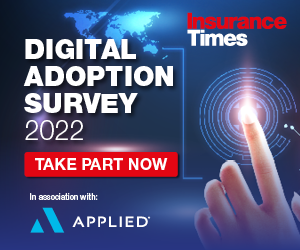Simon Bloomfield, head of Imarket at digital trading focused software firm Polaris, shares some of the key insights that have emerged from Insurance Times’ Five Star Rating Report: ETrading 2022 and Data Insight Book
With the impact of the Covid-19 pandemic and shortage of trained resources across the insurance market, there are more reasons than ever before for insurers and brokers to digitally trade.
Digital trading has offered distribution efficiency to brokers and insurers for simpler risks for a number of years. We are now increasingly seeing a growing appetite for eTrading among brokers and insurers as they are reimagining how digital processes could help their businesses.
Against that backdrop, the annual Insurance Times eTrading survey provides a good barometer for broker sentiment, offering a sense check on what really matters to them.
So, what are my thoughts on this year’s survey and results?
The Insurance Times 2022 eTrading Star Ratings Hub is now live. To view in-depth results, analysis, broker feedback, five year trends and much more, visit https://www.insurancetimes.co.uk/etrading-report-2022. Alternatively, if you would like to view the printed report, please click here.
Service levels
I’m pleased to see this year’s survey highlighting broker expectations around both simple and complex risks in terms of referral expectations, as these different types of risk rightly require a different mindset when trading each of them.
The simple, smaller premium risks are all about quick referrals and getting to decisions quickly to enable the efficiency desired by insurers, brokers and customers.
The more complex products and risks, quite rightly, need more careful consideration and may need to be seen by a number of experts within an insurer, to ensure the broker gets the right answer.
If we look at the referral outcomes that brokers are getting, then there is clearly a difference between simple and complex risks:
| Simple Risk Experience | Complex Risk Experience | Complex Risk Expectation | |
|---|---|---|---|
|
Up to One Hour |
32% |
10% |
12% |
|
Up to Half a Day |
67% |
26% |
36% |
|
Up to a Day |
91% |
59% |
79% |
At the moment, brokers’ expectations aren’t being met by the market.
More than a third (36%) of the brokers polled by Insurance Times expect complex referrals to be dealt with within half a day - however brokers only hear back from insurers within this time frame in 26% of cases.
Similarly, four out of five brokers expect to hear back within a day when it comes to complex risk referrals, yet only three out of five receive this service.
That’s 20% of brokers whose expectations aren’t being met.
Whether this means brokers need to be more patient to get the right answer, or insurers have more work to do on their service levels, is debatable. I suspect the answer lies somewhere in-between.

What we did see mentioned a lot within Insurance Times’ survey results was live chat, with both good and bad comments from brokers on that particular service.
We know from providing the platform for this service, which is used by seven major insurers, that live chat volumes doubled in 2022 compared to 2021.
We will discuss with our live chat working group whether it is technology or resourcing that is behind examples of broker dissatisfaction.
I do expect to see live chat continue to grow in importance - particularly since it typically includes a chat transcript, supporting contract certainty.
I’d also expect insurers to continue to optimise their products, to ensure referrals are restricted to where there is a genuine need for more information.
eTrading channels
When looking at the percentages for why brokers use insurer extranets or software houses’ broker systems, there were some really interesting issues – and potential misconceptions - that were flagged.
Around 23% of brokers use extranets to get a better price. I suspect that while extranets will style questions differently, the broker would get pretty much the same price as on a broker system, so this might be more perception than reality.
Meanwhile, 19% of broking professionals use extranets for contract certainty. While each insurer has their own position on the fair presentation of risk, from my discussions with insurers on this point over a number of years, I am not aware of any insurer that has suggested that brokers using their broker system generated outputs are not considered in the same light as those using their extranet.
A third of brokers (34%) report that insurers encourage them to use their extranet versus 18% that prefer them to access products through broker systems.
This highlights an interesting phase where we are embracing digital adoption, with the majority of brokers not being encouraged to trade in any specific way.
Although brokers would like the option to trade with an insurer in a variety of ways - reflected by hybrid broker systems and extranets being the eTrading route most used by brokers - when this is coupled with other manual routes, it creates increased overheads for insurers. This is then reflected in higher prices or lower commissions on offer.
Automation of insurance processes at scale is the environment we now operate in - insurers and brokers will continue to take advantage and build out opportunities to improve their efficiency in the future, to the benefit of all parties.
Aside from the useful stats on broker systems and extranets, I also looked at the verbatim comments from the research report, to see if they pointed in the same direction.
For broker systems, the top three reasons for using broker systems were:
- The efficiency and time saved.
- Ease of use.
- Ability to compare.

Whereas for primarily extranet users, the top three reasons for picking this eTrading route were:
- Ease of use.
- Broker system isn’t there yet.
- Quicker to use.
For brokers that used both routes for eTrading, the top three reasons for this were:
- Not all products are available on broker systems.
- Extranets sometimes fit better.
- Insurers want brokers to eTrade in a particular format.
What brokers are saying is that, in the main, they want to use their broker system as it saves them time and it is easier to compare. However, where the product isn’t available yet on their system, or where the risk is less straightforward, they will revert to extranets.
Future direction
It’s good to see high levels of feedback in the Five Star Rating Report: ETrading 2022, as this indicates that brokers want digital trading to work for their business.
The products that brokers have suggested insurers develop indicate that digital trading is continuing to evolve into more complex areas. The challenge for the market will be how to develop some of these smaller product lines in a cost effective way, to enable insurers to consider extending their product ranges.
For this to happen, it’s important that brokers back the eTrading model that supports their strategic direction and ensure that when digital products and solutions come to market, that they adopt them throughout their businesses.
From Polaris’ perspective, we continue to see growth in Imarket, which connects brokers and insurers to digitally trade business. Imarket now supports nearly 500,000 annualised policies.

Hosted by comedian and actor Tom Allen, 34 Gold, 23 Silver and 22 Bronze awards were handed out across an amazing 34 categories recognising brilliance and innovation right across the breadth of UK general insurance.




















































No comments yet